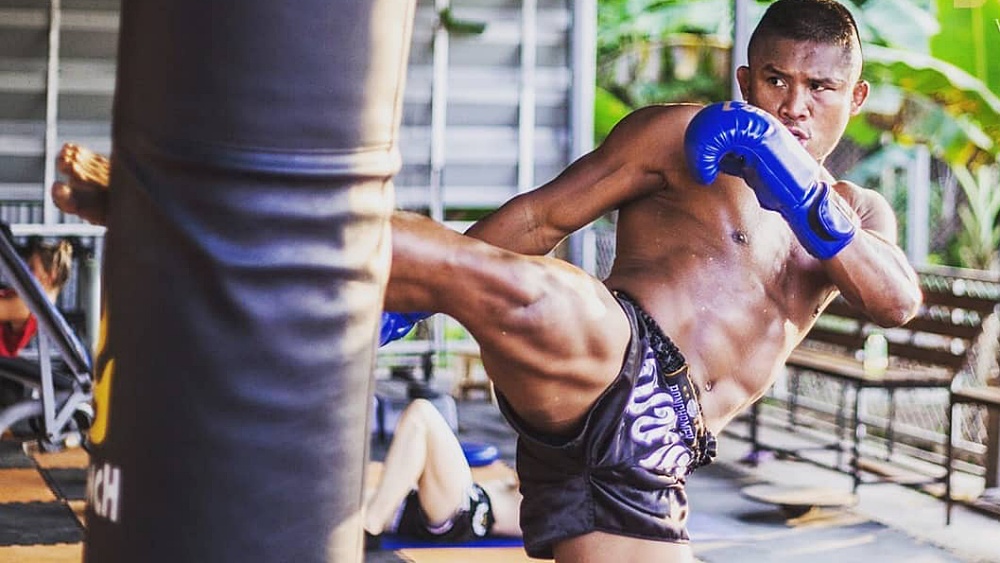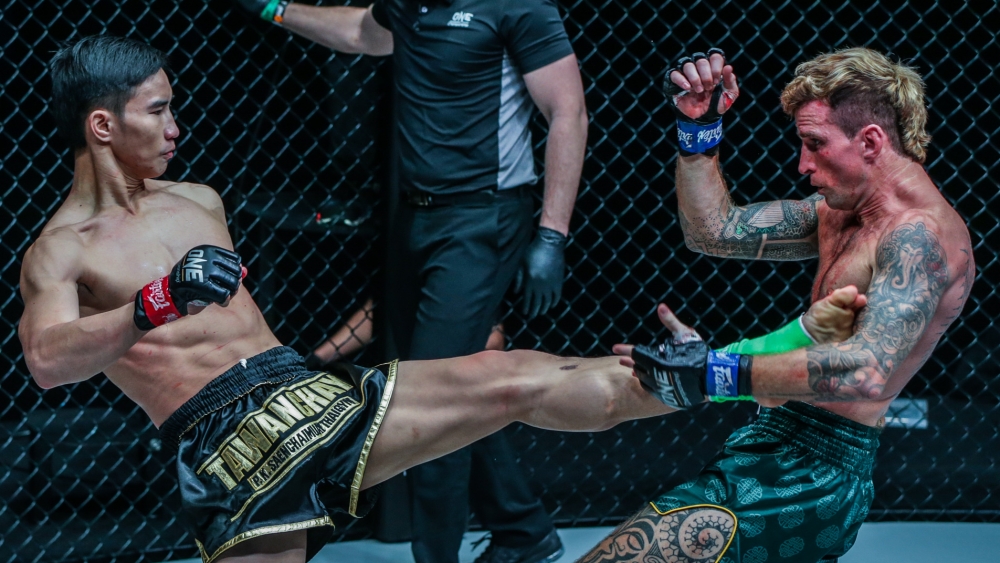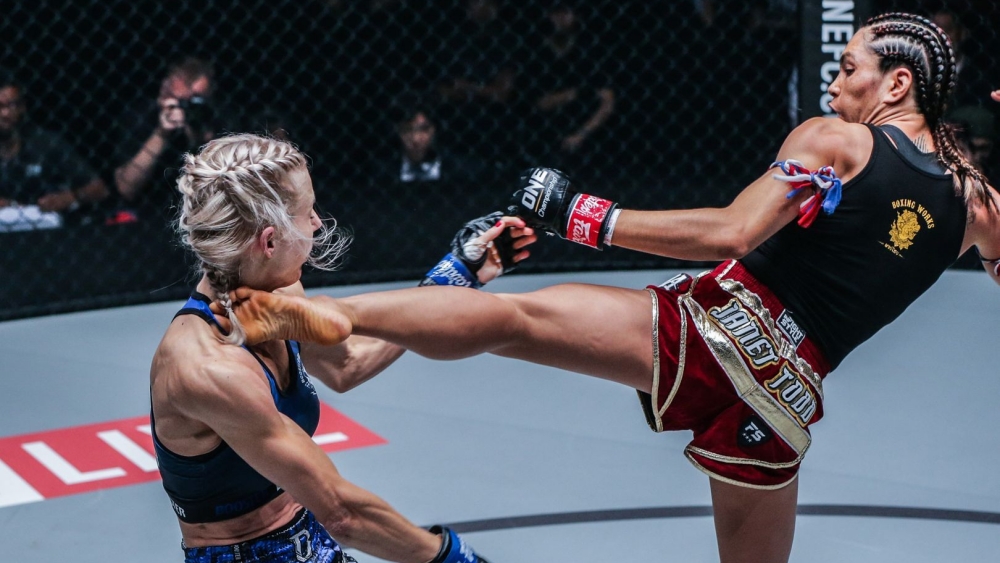In the Muay Thai scene, Buakaw Banchamek, whose birth name is Sombat Banchamek, is a legendary Nak Muay with two hundred and eighty fights to his name. Some of his accolades include being a two-time K-1 World Max champion, as well as being a champion at Omnoi and Lumpinee stadiums. Buakaw’s storied fight career has stood the test of time – he has been active since 1990! Any aspiring fighter can learn much from Buakaw’s tactics and unrelenting Muay Bouk style. Today, Evolve Daily is pleased to share a guide on how to fight like Buakaw Banchamek.
Tight Defense
An underrated and often overlooked aspect of Buakaw’s success in the ring is his stellar defense. Buakaw forgoes many fancier, more “advanced”, defensive options in favor of a solid long guard. He most often holds his rear hand by his cheek, akin to a high guard, while his lead arm is extended in a classic Muay Thai long guard. The long guard effectively shuts down most attacks aimed at the head, while giving you control over your opponent’s posture and hand position. Buakaw will use the long guard to block and walk through heavy strikes, from punches to head kicks with knockout power. He will often use his extended lead arm to frame his opponent’s collarbone while hand-fighting with his rear hand. Once his opponent is off balance and exposed, Buakaw delivers devastating strikes. Above is a video showcasing Buakaw’s use of the long guard.
Buakaw also uses a tight high guard when his opponent can punch around his long guard. This seemingly small adjustment allows for better defense against punches and takes away his opponent’s biggest advantage. In the video above watch Buakaw adapt to his opponents’ looping punches by switching to a high guard.
Lead Teep
Buakaw has one of the best teeps in the fight game. He is able to use his lead teep as both a weapon and a tool to control distance. When an opponent rushes in, Buakaw will quickly lift his leg and teep from just outside punching range. With this type of teep, Buakaw adds just enough snap and hip drive to stop his opponent’s forward movement. This can be deceptively draining as Buakaw aims for his opponent’s solar plexus, making it more and more difficult to breathe with each landed teep. Above is a video showcasing Buakaw’s formidable teep.
Buakaw can also teep from long range. He does this by throwing a hybrid side teep, much like Samart Payakaroon’s teep. Buakaw uses this to force his opponents back, knocking them off balance and leaving them open to follow-up strikes. Above is a video of Samart Payakaroon teaching his variations of teep including the side teep.
Left Roundhouse Kick
One of Buakaw’s most feared weapons is his left switch kick. Whether he aims at his opponent’s head, body, or legs, this strike has the potential to change the course of a fight. In general, lead-side attacks are safer; even if you miss, you will end up in your fighting stance. Most fighters stand with their dominant hand on their rear side. As a result, most fighters have more control and power in their rear-side attacks. Buakaw is a truly ambidextrous fighter; his lead switch kick hits just as hard as his rear side round kick. This makes it especially difficult, and dangerous, for his opponent to charge in recklessly. Buakaw is also able to change the angle of his left round kick, altering the point of impact on his opponent’s body. If he lands with a straight leg, Buakaw’s left round kick will hit his opponent’s body from the side. Alternatively, Buakaw sometimes opts to land with his leg bent. This lets his entire shin make contact from the front of his opponent’s body, stopping their forward momentum. One of the best ways to train your own lead switch kick like Buakaw is heavy bag rounds. An example would be to just practice your lead switch kick for 3 rounds. During the first, practice landing with a straight leg. For the second round, practice landing your kick with a bent leg. Put them together for the final round; you can alternate between the two or create your own pattern! Above is a video showcasing Buakaw’s formidable left kick for inspiration.
Lead Side Fluidity
Buakaw’s lead side is so formidable partially due to the variety and fluidity of his strikes. In addition to his lead side teep and round kick, Buakaw often uses a lead switch knee to attack his opponents. Between those three strikes, Buakaw has multiple weapons for long, medium, and close range. This makes it very difficult for his opponent to read or predict his attacks, giving Buakaw time to implement his game plan. Check out the video explanation by World Champion Kickboxer Gabriel Varga on Buakaw’s lead side dominance.
To develop lead side fluidity, it is essential to revisit and master the basics of each technique. All of Buakaw’s lead side kicks come from a chambered position with his knee bent. This is what makes his lead-side attacks so hard to read. This makes you more dangerous offensively as well. Because all of your lead side kicks start from the same position, you can decide what to throw based on your opponent’s reaction. For example, if you attempt to land a lead switch kick on your opponent, they may close the distance to stifle your kick’s power. You can adjust mid-kick, from the chamber, to land with a bent leg, stopping them in their tracks. Having so many options to deal with can leave an opponent mentally overwhelmed, giving you ample opportunity to land your offense.
Buakaw blends Western boxing into his own Muay Thai style seamlessly, using head movement to evade his opponent’s punches while loading power into his own. Head movement is less common in Muay Thai due to the danger of running into kicks or knees. Despite this, Buakaw uses pulls, slips, and rolls uniquely and effectively. For example, many Nak Muay attempt a sweep when they catch their opponent’s kick. Instead, Buakaw will simply drop his opponent’s leg while slipping his head to the outside and landing his lead hook simultaneously. Dropping the opponent’s leg forces them to fall towards the lead hook, creating a head-on collision. Above is a video clip showcasing this very technique.
Although he is known for his explosive knockout power, Buakaw has an extremely high ring IQ. He utilizes his lead side just as fluently as Muay Femur such as Saenchai, controlling the distance and pace of the fight. Buakaw primarily uses basic strikes, but the timing and execution of those strikes are what sets him apart from other Nak Muay.
Buakaw’s signature heavy low kicks are an example of his high ring IQ. When Buakaw is fighting an opponent with an active lead leg, he targets their back leg to increase damage and reduce the risk of his kick being checked. This is where timing comes into play. The optimal time to land a low kick on an opponent is when the majority of their weight is on one leg. That leg is momentarily stuck; to check a kick, the opponent would have to shift all of their weight onto the opposite leg before starting to check your kick. This takes a very long time compared to the time it takes to throw and land a hard low kick, making it almost impossible to defend. Each consecutive low kick landed saps the opponent’s stamina, power, and ability to move. This is one of the reasons low kicks are so effective in general.
If Buakaw is fighting an opponent with a heavy lead leg, he will target the lead leg as the opponent attempts to strike. Many fighters favor a heavy lead leg for power punching and head movement. The downside of a heavy lead leg is that you are far less mobile; your lead leg is stuck in place momentarily after punching or moving your head. This makes it a prime target for low kicks. Because the majority of the opponent’s weight is on the lead leg, checking kicks becomes almost impossible.
Buakaw being able to identify his opponent’s weight distribution in the midst of a fight is one of the reasons he is considered a legend in Muay Thai. The accumulation of details such as this is what separates good fighters from world champions. Skip to 4:02 in the video below to see the above concepts used in an actual fight.
Clean Technique
Buakaw has near-picture-perfect technique, continuing to improve even after a career spanning over three decades! This dedication to the craft of Muay Thai is what separates him, and other legends, from everyone else. Regardless of where you are personally on your Muay Thai journey, your technique can always be improved. Doing so will improve your skills little by little, giving you an inherent edge over any competition. Even if you are a hobbyist, strive for perfection every time you train. You will get far more out of your training if you spend time perfecting one or two techniques at a time, instead of practicing a new combo every day.
From the retraction of punches to something as seemingly simple as maintaining stance while moving, Buakaw has spent countless hours honing his skills to score a victory against his opponents. To work on your technique, start with the basics and slowly drill the movements from start to finish until they are ingrained in your muscle memory. Start with simple footwork in all directions, ensuring that you return to your exact stance between each step. Then slowly practice your basic punches and kicks. Pay close attention to the trajectories of each strike, making sure to intentionally control the extension and retraction manually. While doing this, be sure to maintain steady breathing and activate your core. Although this may seem tedious, working on the basics in this manner will elevate your skill level immensely.
Physical Conditioning
Buakaw’s level of physical conditioning is insane, and it is one of his greatest advantages over his opponents. He is able to maintain a consistent output for the course of an entire fight, throwing sixty to seventy percent of his maximum power with each strike. Buakaw’s cardio allows him to apply pressure on his opponent and push the pace of the fight to his advantage. He also trains for strength endurance – that is, the ability to continuously output force over and over again. Without strength endurance, you would be able to throw many strikes before gassing out; however, only your first few strikes would land with any power. Strength endurance gives you the ability to throw continuously with power throughout multiple rounds. In addition, Buakaw also trains for explosive power – the ability to put maximum force in a single strike. This is what lets him capitalize on his opponent’s weaknesses, overwhelming them and knocking them out with a single blow.
Everyone’s body is different; the goal of improving your physical conditioning is not to be a clone of Buakaw but rather to realize your own individual physical potential. Some people have a propensity for strength and endurance. Others may find that training explosive power and cardio yields better results. A good place to start your conditioning journey is the heavy bag. You can hit it however hard or soft, and set your own pace. Heavy bag work will allow you to work on cardio, strength endurance, and explosive power, depending on your routine. In addition to increasing your physical conditioning, heavy bag work allows you to directly link your technique with your physical fitness, making it a very applicable mode of training. Here is a video of Buakaw himself working the heavy bag.
Heart Of A Fighter
Possessing the heart or spirit of a fighter is a key element to any Nak Muay’s success, including Buakaw. Muay Thai is a form of self-expression and artistry, and developing your skill set should be treated as such. Buakaw is a legend, in part, because of his authenticity towards himself; his style is his, and his alone. Although incorporating elements of various styles can make you a more well-rounded fighter, it will not give you what Western boxers call grit. The heart of a fighter is shown in the ability to persevere, endure, and overcome any challenge in your way and is a core tenet of Muay Thai. Add the concepts discussed above into your training, and more importantly, train often and hard!
You may also like:
Reflecting On The Golden Era And The Current Era Of Muay Thai Fighters
















